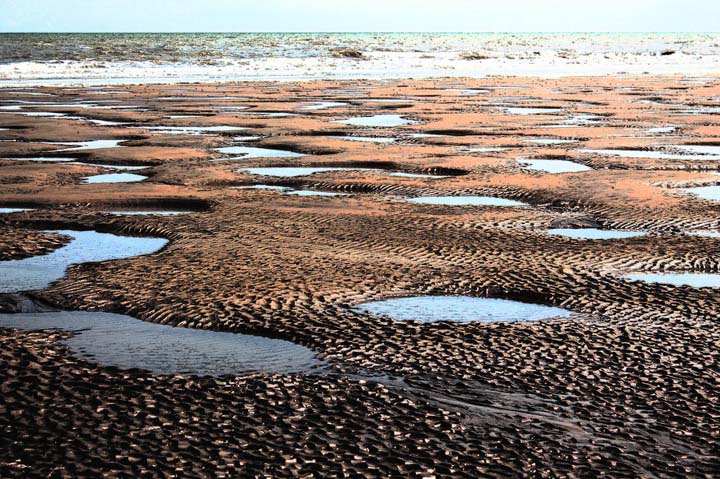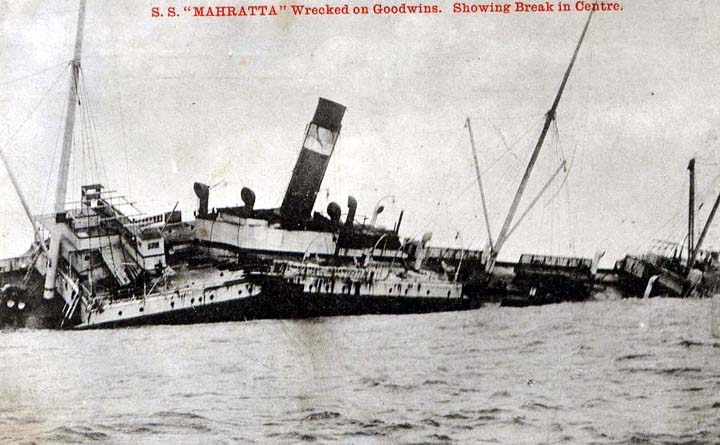
|
|
|
What's IotD? The interesting, amazing, or mind-boggling images of our days. |
|
IotD Stuff |
|
Permalink Latest Image |
|
|
|
Some folks who have noticed IotD
Neatorama |
|
Common image haunts
Astro Pic of the Day |
|
Advertising |
Nov 26th, 2016: Goodwin Sands
|
Six miles off the coast of Deal in East Kent, England, lies one of the most treacherous stretches of sand in Britain. Lying in the middle of the English channel in the narrow Straits of Dover, close to one of the busiest shipping channel in the world, the sands present a great challenge to navigators. Since the first documented shipwreck on Goodwin Sands in 1298, more than 2,000 ships are believed to have wrecked here. Dozens of wrecks still lie underneath the waves. |

|
The Goodwin Sands is about 10 miles long and 3 miles wide at its widest, but because of the tides and currents, the shoals are constantly shifting. Usually, the sand remains completely submerged between 8 to 15 meters beneath the surface, but as the tide falls, the sandbank break the surface and expose about a tenth of their total area. During these times, the sand is firm enough to walk upon. Typically, a ship would run into the sand during rough weather and begin to break. Any survivor who manages to escape onto the sand might have been able to light fires and attempt to attract the attention of passing ships, or the Boatsmen of Deal and Kingsdown. If help didnít arrive within hours, the tide would return and the sand would turn into quicksand, and ships and survivors would be engulfed. |

|
Modern navigation technology, particularly that assisted by GPS, and detailed mapping of the channel now allow ships to avoid the Goodwin Sands. There have been no major accidents here since a lightship capsized in 1954 killing six crew members. There is currently one lightship on the end of the sands to warn ships. The sands were once covered by two lighthouses on the Kent mainland, one each covering the north and south ends of the sands. The South Foreland lighthouse is now owned by the National Trust, and the North Foreland lighthouse is still in operation. |

link
Snakeadelic Saturday Nov 26 09:14 AM
I haven't lived on the Oregon coast since 1983. I do still get to beachcomb there once a year, usually for 2 days. I find I still remember how every summer there would be hysterics because someone either got caught by a sneaker wave, went out on the rocks when the tide was coming in, or got grabbed by a riptide.
I also find I don't turn my back on the Pacific until I'm above the high-tide mark. Those like 5 years being right on the beach apparently drove that one in pretty deep! Oceans are, indeed, not safe for humans.
Carruthers Saturday Nov 26 11:22 AM
Attachment 58621
A screen grab of shipping in the English Channel this afternoon in the vicinity of the Goodwin Sands with the East Goodwin light vessel circled.
There's a managed traffic system through the Straits of Dover with SW bound traffic on the English side and NE bound on the French side.
What complicates matters is the constant to and fro of the cross channel ferries marked in dark blue on the map.
See www.marinetraffic.com
One man survived the capsizing of the South Goodwin light vessel (referenced above) but no trace was ever found of the six remaining crew members.
| The Straits of Dover is the busiest shipping lane in the world. Just north of its narrowest point stands the Goodwin Sands: 35 miles of shifting sands have been the graveyard to Viking longships, galleons, liners, tugs, yachts and trawlers of every nationality and a lightship - the South Goodwin lightship LV 90. Tom Skipp was a worried man on the evening of 26 November 1954 as he prowled the deck of LV 90, checking that all was secure. Huge waves were already sweeping the deck, putting a strain on the 410 metres of heavy cable. Below, the crew were doing their best to protect themselves from the sudden jerking movements, as the wind, now a hurricane force 12, and a full flood tide battered the lightvessel. Sometime between midnight and 01:00 the cable parted but such was the battering no one would have known. Ashore, Ramsgate and Deal Coastguard were worried, but visibility was low. Suddenly, at about 01:15, LV 12 the East Goodwin Light Vessel saw its sister ship sweep past six miles north of the station; they could only watch in horror. The crew, we know, mustered in the galley and shortly afterwards the ship hit the sands in Keller Gut, collapsing onto her starboard side. Inside, the men were fighting for survival, the galley door was under water sealing off the exit, but one man, the survivor Ronald Murton, scrambled through the skylight and into the inferno that was raging above. Meanwhile lifeboats from Dover and Ramsgate and a United States search and rescue helicopter from Manston were launched, but it was not until daylight that the wreck was located by the helicopter. In an amazing feat of accurate flying, for which the crew received bravery awards, the helicopter snatched Murton from the hull. He had survived the worst channel storm in two centuries. His first words were for his fellow crewmen whom he knew were still alive in the hull. But even as the rescue operation for them was being launched the race against time and tide was being lost. The lifeboats could not get near to the light vessel and within hours the tide had enveloped her and those trapped inside her hull. The extreme weather lasted a further day, and on 28 November divers eventually were able to get on board. There was no trace of the crew; not a single body was recovered. The ship did not disappear entirely however and at low tide traces of her can still be seen today. |
|
PARKINS Curtis E., Captain, United States Air Force, 66th Air Rescue Squadron 27 November 1954: Gales of exceptional force had been blowing for several days off the East Kent coast and, early in the morning, it was noticed that the South Goodwin light vessel had disappeared. Lifeboats at Ramsgate. Dover and Walmer were warned and, during the night, the first two launched and carried out searches of the Goodwins without success. At daylight, the vessel was located on her beam ends, lying on her side where she had drifted. The Walmer lifeboat launched. The combined efforts of all three boats could not detect any survivors, therefore a call was made to 66th Air Rescue Squadron. U.S.A.F., which provided a helicopter from its base at Manston, Kent, near Ramsgate. A second sortie at 9 a.m. by Captain Parkins noticed a solitary figure - a Ministry of Agriculture and Fisheries bird watcher - clinging to the light vessel's superstructure. Ignoring the normal rules, the helicopter was brought down to 30 feet and, in spite of the wreckage and spray, the lone survivor was plucked from his refuge and landed safely at Manston. This was the first R.N.L.I. medal to be awarded to any pilot of any aircraft and also the first service given by a helicopter when lifeboats, although present, were unable to render the necessary help. |
Diaphone Jim Saturday Nov 26 12:18 PM
A sort of Atlantis, but rising and sinking twice a day.
One thinks at first that sand would be less dire than rock, but this shows that it has its own terror.
"...survivor Ronald Murton, scrambled through the skylight and into the inferno that was raging above."
Though it must have been hell-like, "inferno" struck me as a strange description of conditions on the Straits of Dover in late November (this very date, thank you Bruce).
footfootfoot Saturday Nov 26 01:18 PM
Maybe a repost, but a great read: Testicular Navigation
https://www.ifa.hawaii.edu/friends/T...of_Oceania.pdf
Carruthers Saturday Nov 26 02:04 PM
There are a number of images illustrating the helicopter aspect of the rescue operation in a topic on the Professional Pilots Rumour Network.
LINK
xoxoxoBruce Saturday Nov 26 02:14 PM
Poppycock, the same aliens that built the pyramids moved the natives from island to island. 
Gravdigr Saturday Nov 26 02:42 PM
I still think 'Goodwin Sands' sounds like someone's name.
Griff Saturday Nov 26 05:28 PM
Pretty sure Goodwin Sands played in the Tower of Power.
Gravdigr Saturday Nov 26 11:09 PM
I thought maybe he was one of the Commodores...

elSicomoro Sunday Nov 27 12:37 AM
Ohio Players
classicman Monday Nov 28 01:10 PMLike an author or a politician - either way, a rich man...

footfootfoot Monday Nov 28 08:26 PM
Sounds like a typeface, Goodwin Sans
|
Your reply here?
The Cellar Image of the Day is just a section of a larger web community: a bunch of interesting folks talking about everything. Add your two cents to IotD by joining the Cellar. |
